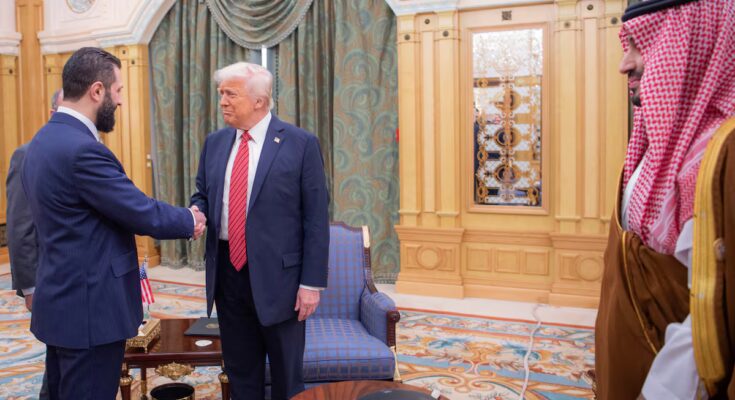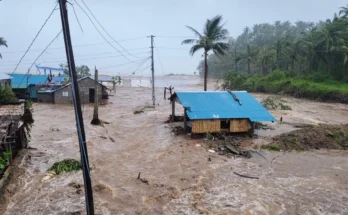It would have been unimaginable just a year ago. Syrian President Ahmed al Shara will be the first leader of his country to visit Washington this Monday and to be received at the White House by an American president. The Donald Trump administration is already preparing to woo the former jihadist fighter in a big way, for whose leader Washington offered, until last December, a reward of 10 million dollars (nine million euros). The United States and the United Kingdom withdrew sanctions against him last Friday, a day after the UN Security Council did so, while the European Union confirms it will do the same.
Washington and London have also lifted sanctions against Syrian Interior Minister Annas Khatab, as indicated by the State Department and the Foreign Ministry respectively. “These actions are taken in recognition of the progress demonstrated by the Syrian leadership since the departure of Bashar al-Assad (the dictator whose regime fell dramatically late last year after more than two decades in power),” the State Department notes. Among the progress mentioned in his declaration are the fight against drugs, the contribution to regional security and the elimination of chemical weapons.
The day before, the US ambassador to the United Nations, Mike Waltz, had welcomed the lifting of sanctions imposed by the UN Security Council against Syria as “a strong political signal” to recognize that Damascus has entered “a new era”.
Both Al Shara – known until recently by his nom de guerre, Abu Mohamed al Julani – and Khatab had been included on the US list of specially designated global terrorists and were subject to sanctions for their links to the Islamic State (ISIS) and Al Qaeda. In May, Trump had already announced that he would lift US sanctions against Syria, in what represented a 180-degree turn in Washington’s traditional policy towards the eastern Mediterranean state.
The White House has decided to take a leap of faith towards the new Syrian regime, while acknowledging its concern about the outbreak of violence against minorities in the south and in the coastal area. For Washington, Syria is a key piece in the Middle East puzzle and in its strategy to redesign the architecture of alliances in the region. According to Western sources familiar with the situation on the ground, a good relationship with Damascus is essential, in the eyes of the Trump administration, to guarantee Israel’s security, prevent Russia from recovering the influence it has exercised for decades in the Arab country and prevent a resurgence of the Islamic State or similar groups in the area.
For the regime formed in January, after the lightning offensive led by Hayat Tahrir el Sham – the rebel group led by Al Shara and, until 2016, affiliated with Al Qaeda – which overthrew El Assad, it is essential that Syria reconnects with the rest of the world, obtains international legitimacy, receives aid for a reconstruction which will require over 200 billion dollars (about 170 billion euros), according to the World Bank, and can develop economic and diplomatic ties with Western Powers.
The US president had already greeted Al Shara, in a meeting facilitated by the Saudi crown prince, Mohamed bin Salman, during Trump’s visit to Riyadh last May. There was an apparent connection between them. The Republican described his Syrian counterpart with some of the most flattering words in his vocabulary: “a young, attractive guy,” who “has potential and is a real leader.”
Al Shara landed in Washington on Saturday, the same day the Syrian government announced that 61 raids had been carried out in different regions of the country that ended with the arrest of 71 suspected ISIS members. Al Shara could sign some sort of collaboration agreement with the international coalition against Islamic states led by the United States during his stay in Washington. Syrian forces have already coordinated on several occasions with those of the Coalition, which still operates against ISIS cells in the region.
According to the Reuters news agency, the United States Central Command (CENTCOM, whose area of action includes the Middle East) is preparing to establish an American air base south of Damascus to strengthen the Syrian government’s efforts to control the multi-ethnic country after thirteen years of civil war.
Trump could also insist on the message already sent to Al Shara during the Riyadh meeting: his interest in Syria joining the Abraham Accords, through which several Muslim-majority countries begin the process of normalizing relations with Israel. The Abraham Accords are the great pride of his first term and the Republican has a great interest in revitalizing and expanding them. A few days ago, Kazakhstan, the largest country in Central Asia, joined in a largely symbolic step: Astana already has diplomatic and economic relations with Israel.
But Damascus has shown no sign of much interest in normalizing relations with a neighbor that has occupied part of its southern territory in the Golan Heights – where the current Syrian president’s family is from – since the 1967 Six-Day War, and which has recently invaded more Syrian territory for reasons of protecting its own national security.
The current Syrian president was captured in 2006 by the US army in Iraq and spent five years, without trial or charges, imprisoned in various detention and torture centers run by those troops. Among these, Camp Bucca and the infamous Abu Ghraib prison, synonymous with humiliation and mistreatment of prisoners by American soldiers.
Before Riyadh’s greeting, the last time an American president and a Syrian leader met was in Geneva in 2000, when Bill Clinton and Hafez al-Assad, Bashar’s father, tried unsuccessfully to agree on a peace between Syria and Israel, after years of contacts fostered by the 1991 Madrid Conference.



